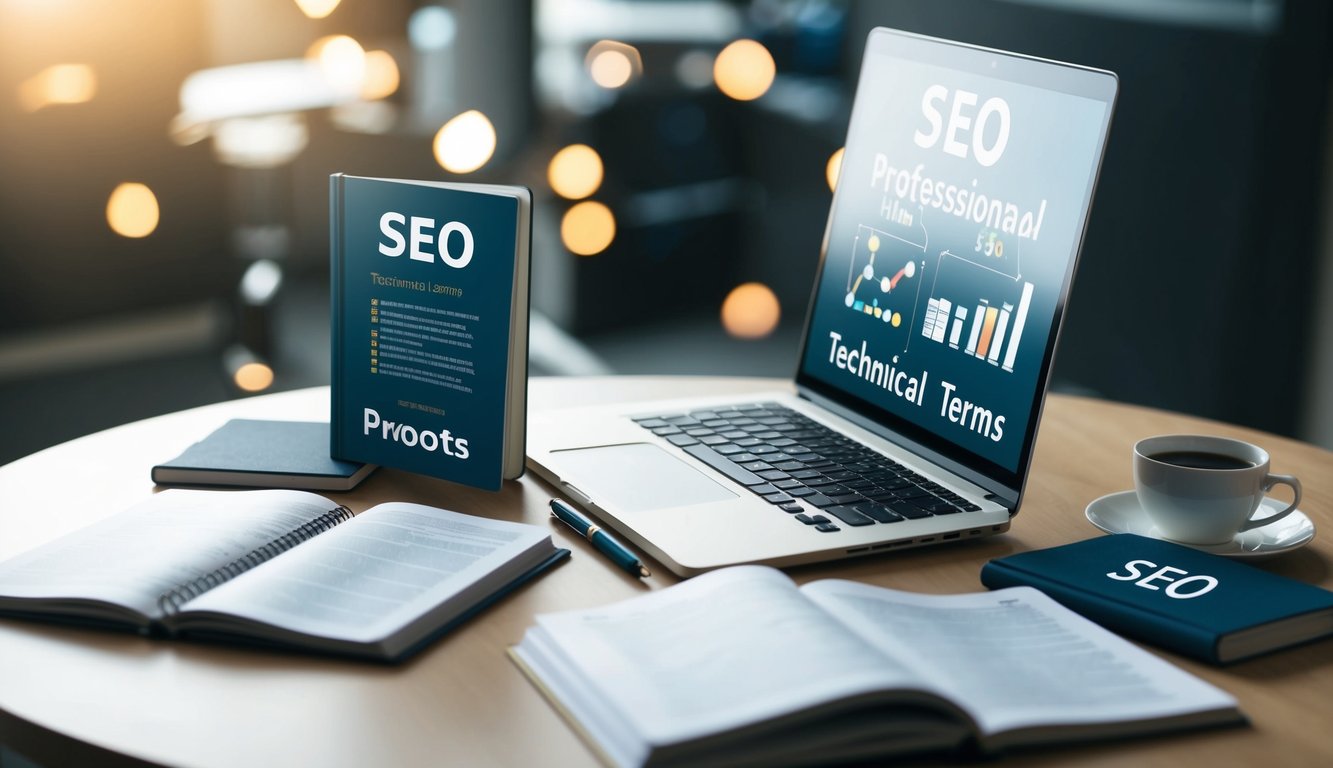SEO Terminology Demystified: Glossary of Key Terms for Beginners
Diving into the world of SEO can feel like entering a labyrinth filled with cryptic terms and mysterious practices. Unlocking the secrets of these terms can be your key to mastering the intricacies of search engine optimization.
Whether you’re struggling to decipher what “crawling” means or wondering if “keywords” are the same as your secret search queries, this introduction to SEO terminology is your golden compass.

Imagine finally knowing what all those three-letter acronyms buzzing around digital marketing meetings actually stand for. From understanding the nuances of on-page optimization to demystifying off-page strategies, this guide will shine a light on the language of SEO.
Don’t be surprised if you start speaking fluent SEO by the end of this read—almost like you’ve cracked an ancient code.
In the confusing realm of SEO, clarity can make all the difference. This glossary of key terms will equip you with the vocabulary you need to confidently navigate the digital landscape and optimize your site’s presence.
Get ready to conquer the search engine world one term at a time.
Key Takeaways
- Learn essential SEO terminology.
- Understand on-page and off-page strategies.
- Gain insight into technical SEO.
Fundamental SEO Vocabulary
Welcome to the world of SEO. Here, you’ll encounter terms that seem complex but are vital to mastering your digital presence. Let’s dive into the essentials you need to know.
On-Page Optimization
Ah, the bread and butter of SEO. On-page optimization involves fine-tuning individual web pages to rank higher.
Start by focusing on keywords; these are the phrases that folks type into Google when they’re searching for something.
Next, look at your title tags and meta descriptions. They’re not just digital decoration. They should be clear, descriptive, and include your keywords.
Your content needs to be like a well-thumbed book: structured with headers, bullet points, and concise paragraphs to maximize readability and engagement.
Off-Page Strategies
This is all about building credibility beyond your website’s borders.
Start with backlinks—think of them as endorsements from other websites telling search engines you’re worth their while. The more reputable the site linking back, the better your chances of climbing those search results.
Social signals from platforms like Facebook and Twitter can enhance your reputation. They don’t directly affect your SEO but keep your brand buzzing.
Networking with influencers and bloggers to mention your site is also a strong move in off-page strategies. Consider guest blogging for that extra push.
Technical SEO
Preference for what’s under the hood? Technical SEO might be your jam. It’s about serving up a fully optimized and search-engine-friendly website.
Begin with site speed because nobody likes waiting, least of all, your potential customers.
You need to ensure your site architecture makes navigation easy for both humans and search engine crawlers. A clean URL structure isn’t just for aesthetics; it’s for functionality and search engine findability.
With SSL certificates, you’ll bolster site security—a factor that search engines take seriously.
Analytics
Sure, you’ve got the foundations, but without analytics, you’re flying blind.
Google Analytics is the go-to for monitoring site traffic and user behavior.
Too shy to face the cold, hard data? Turn to Click-through Rates (CTR) which show how many people are taking the bait on your tantalizing meta descriptions.
Then there’s bounce rate—how quickly people leave your site after arriving. Hint: Aim for a low one to ensure engagement.
Use tools to track these metrics, so you always know where you stand.
On-Page Optimization Terms
When it comes to SEO, getting your on-page optimization just right is key. From tweaking meta tags to perfecting your internal linking strategy, these elements work in harmony to boost your search engine rankings.
Meta Tags
Meta tags might sound like something a wizard would use, but they’re all about providing information to search engines.
The two heavyweights here are the title tag and meta description. Your title tag should be a concise, keyword-rich headline, while your meta description provides a short summary of the page’s content.
Done well, they entice both search engines and humans, driving clicks and improving visibility. Make them count because search engines use this info to gauge your page’s relevance to queries.
Header Tags
Header tags run the show when it comes to organizing your content. Think of them as a textbook’s chapter headings; using
for your main topic and or for subtopics clarifies your page’s structure.
for subtopics clarifies your page’s structure.
Not only does this hierarchy make your content skimmable for users, but it also helps search engines understand the content hierarchy on your page. Sprinkle in some keywords to boost relevancy, but avoid overdoing it.
Keywords
Ah, keywords, the bread and butter of SEO. Identifying the right keywords ensures you’re speaking the same language as your audience.
Once you’ve nailed your keyword research, incorporate them naturally into your content, focusing on maintaining readability. Avoid stuffing them in like a turkey. It’s about balance, relevance, and providing value to your readers.
This strategy ensures that your content appears in the right searches without making it seem forced.
Content Optimization
Let’s talk about content optimization, the art of making your page worthy of search engine love.
High-quality, relevant content keeps users engaged. This means your text should be informative, authoritative, and aligned with your audience’s needs. Don’t forget to mix in media elements like images or videos to enhance engagement.
Crafting well-optimized content improves user experience and boosts time spent on your page, which search engines adore.
Internal Linking
Internal linking is like setting up a web of connections within your site. Use these links to guide users (and search spiders) to related content, improving navigation.
They help distribute page authority across your site and encourage readers to stay longer. Great for highlighting your cornerstone content, these links can boost SEO by showing search engines the hierarchy and structure of your site, one click at a time.
Off-Page Strategies Terms
Engaging in off-page strategies is like networking for your website. It’s not just about what’s happening on your homepage, but also about how the entire online ecosystem perceives you. Understanding these terms can elevate your website’s status.
Backlinks
Ah, backlinks, the glamorous endorsements of the digital world. When a reputable site links to yours, it’s like receiving a gold star for your content.
Quality over quantity is the name of the game here. Google’s algorithms value links from authoritative sites far more than from a dozen shady blogs. It’s a trust signal, giving your site credibility and a push in the search rankings.
You want to aim for links that are contextually relevant. If you’re running a bakery blog, a link from a culinary magazine carries more weight than one from a random tech site. Broken link building and skyscraper techniques are popular methods to score these valuable backlinks.
Domain Authority
Domain Authority (DA) is your website’s reputation index. Developed by Moz, this score predicts how well your site will rank on search engines.
Think of it as a credit score but for websites. The higher your DA, the better your chances of ranking high.
DA considers multiple factors like the number of backlinks and their quality. Keep in mind that increasing your DA isn’t instantaneous. It requires time, consistent quality content, and strategic link-building.
Tools are available online to check your DA, helping you track your growth and progress.
Social Signals
Social signals consist of likes, shares, and comments from social media platforms that measure online engagement. These interactions can influence search rankings, showing that your content resonates with the audience.
While not a direct ranking factor, the buzz around your post can lead to more visibility and traffic.
Social media platforms are the frontline for generating social signals. Craft compelling content that users want to engage with and share widely. Engaging in conversations and responding promptly to comments can amplify your influence, indirectly boosting search engine performance.
Guest Blogging
Guest blogging involves writing content for other sites to enhance your visibility and earn backlinks. It’s a dual-purpose tactic: gaining exposure to a new audience and increasing your site’s authority. Plus, it’s a chance to prove you know your stuff.
Always target reputable sites within your niche, and avoid spammy blogs that might harm your site’s reputation. Quality matters here; your guest posts should be as compelling and well-researched as the content on your own site.
A byline on a respected site equals golden traffic opportunities.
Influencer Outreach
Influencer outreach is about cozying up to those who already have the audience you covet. These are the folks whose endorsement can make your content go viral overnight.
The trick is making this relationship mutually beneficial and genuine.
Forget mass emailing generic pitches. Personalize your outreach efforts. Offer value, be it through exclusive content, discounts, or collaborations.
Influencers can amplify your message to a broader audience, bringing in traffic and improving your brand image. Their reach often translates into those precious backlinks and social signals you’re after.
Technical SEO Terms

You’re diving into the world of Technical SEO, aren’t you? Prepare yourself to learn about crucial elements like Crawling, Indexing, Mobile Optimization, Site Speed, and Structured Data. These terms are like the unsung heroes of SEO, quietly working behind the scenes to improve your website’s visibility and performance without asking for too much attention.
Crawling
So, what’s the deal with crawling? It’s the process search engines use to discover your fabulous web pages.
Picture a tiny digital spider scuttling across your content, taking notes about everything it sees. Unlike actual spiders, this one is your friend.
This little crawler evaluates your site’s content and links, making sure everything is indexed correctly. A key aspect is ensuring your site’s architecture allows crawlers smooth access. Inaccessible or blocked pages? Not on its watch.
Tools like Google Search Console can come in very handy to monitor and guide what gets crawled, allowing you to optimize which pages demand the spotlight.
Indexing
Once the crawling is done, next up is indexing. Think of this as your web pages’ induction into the search engine hall of fame.
Search engines now decide which parts of your site deserve a space in their vast libraries. It’s where your content is evaluated and categorized.
Good content with relevant keywords is crucial, but don’t think keyword stuffing will earn you points—quite the opposite, really.
Focus on creating unique, valuable content that serves your users. Submit sitemaps to search engines to ensure nothing gets overlooked. Remember, if it isn’t indexed, it’s like it doesn’t exist online.
Mobile Optimization
Welcome to 2024. Everyone’s got a smartphone, and mobile optimization is non-negotiable.
Poor mobile experience can send potential visitors running in the opposite direction, faster than you can say “bounce rate.”
Your site needs to look as good on a phone as it does on a desktop. Responsive design is the name of the game here, ensuring your text, images, and buttons scale perfectly.
Use tools like Google’s Mobile-Friendly Test to confirm your site wins in the mobile department. Don’t forget: a smooth mobile interface not only keeps users happy but also gives you a boost in mobile rankings.
Site Speed
No one likes waiting, especially not online. If your site crawls slower than molasses in winter, it’s probably losing traffic faster than free hotcakes.
Site speed is vital, not just for user experience, but for your search rankings, too.
Minimize large images, leverage browser caching, and reduce server response time. Tools like Google PageSpeed Insights can inform you where your site could be snappier.
Visitors expect (and deserve) a fast and seamless experience, meaning every extra second your site takes to load could cost you dearly—a speedier site can ensure fewer users wave goodbye.
Structured Data
Structured data might sound dull, but trust me; it’s a powerhouse. It provides richer search results and lets search engines better understand your site’s content.
Imagine your pages showing up with stellar levels of detail—a digital VIP experience.
Implementing structured data can enhance search results, thanks to the magic of rich snippets. From star ratings to product prices, this data ensures your site contains descriptive and directly relevant details to catch the eye.
Use tools like Google’s Structured Data Markup Helper to add some flare to your content. Proper use lets search engines accurately categorize your site, increasing its usefulness to searchers.
Analytics Terms

In the world of SEO, analytics terms are the bread and butter of understanding how your website performs. They provide insights into aspects like website visitors, user engagement, and performance metrics that are essential for optimizing your digital strategy.
Organic Traffic
Organic traffic refers to visitors who land on your website through unpaid search results, the holy grail of SEO. Unlike the “pay-to-play” ad traffic, this traffic comes from people who find your content valuable enough to click through without incentives.
Quality content, strategic keywords, and a user-friendly site all contribute to boosting this metric.
You can use tools like Google Analytics to track organic traffic metrics effectively. This data helps you understand which pages draw visitors and which keywords land them there. More organic visits generally indicate a higher ranking in search engines, signaling your site’s credibility and utility.
Bounce Rate
Bounce rate is like the awkward party guest who just won’t stick around. It measures the percentage of users who visit your page and then leave without interacting further. A high bounce rate can suggest your landing page is underwhelming or that users aren’t finding what they are looking for.
Analytics tools help you track how often this happens and on which pages. Consider improving readability or content quality if your bounce rate is climbing.
It’s not just about getting people to land on your page but ensuring they stay long enough to explore and, ideally, engage further.
Conversion Rate
The conversion rate is where the real magic happens. It’s the percentage of visitors who complete the desired action on your page, such as making a purchase or signing up for a newsletter. This metric is your digital handshake, confirming that you’ve met your objectives.
A high conversion rate indicates an effective call-to-action and user-centric design.
Using A/B testing and clear calls-to-action can optimize this rate. Understanding what works, whether it’s a witty headline or a compelling layout, can significantly boost your conversion figures and, ultimately, your bottom line.
Click-Through Rate (CTR)
CTR is your website’s way of saying, “Hey, thanks for choosing me!” It calculates the ratio of users who click on your link compared to those who merely see it. A good CTR depends on your industry but often suggests your headlines and snippets are appealing to your audience.
Monitoring CTR can help you gauge how your site performs in search results. Improved meta descriptions and keyword optimization are your allies in this battle.
A higher CTR usually equates to more targeted traffic and, potentially, higher conversions.
Keyword Rankings
Keyword rankings are the positions of your site in search engine results for specific keywords. High rankings for useful and relevant keywords indicate your content’s significance and can lead to more organic traffic. They are the lighthouse guiding your potential visitors to you.
Maintaining or improving these rankings involves a meticulous blend of keyword research, optimization, and content quality. Regularly tracking your rankings ensures you aren’t losing ground to competitors and can inform adjustments in your strategy.
Effective keyword management can catapult your site in visibility and relevance, paving the way for greater success.
Conclusion

So, you’ve made it to the end, and now you’re basically an SEO wizard.
You’ve grilled through algorithms, crawled through meta tags, and maybe even scoffed at the term “black hat.” Pat yourself on the back.
Key takeaways:
Crawling & Indexing: Search engines are like those nosy neighbors, always looking through your stuff. Understanding this can give your site the visibility it deserves.
On-page SEO: Think of it as tidying your room before guests arrive. It’s all about first impressions and keeping Google’s bots impressed with your housekeeping skills.
Off-page SEO: Networking is not just for humans. Building reputable links is essentially your site’s way of making friends in high places.
Being well-versed in SEO terms isn’t just a nifty party trick, it’s a skill. Whether you’re optimizing your site or prepping for some serious competitive analysis, solid knowledge serves you well.
Remember, SEO is more of a marathon, not a sprint.
If everything seems overwhelming, start with the basics. Master the glossary, and soon, you’ll be navigating SEO waters like a pro. Who knew that diving into technical jargon could be this much fun?
Now, go forth and optimize!